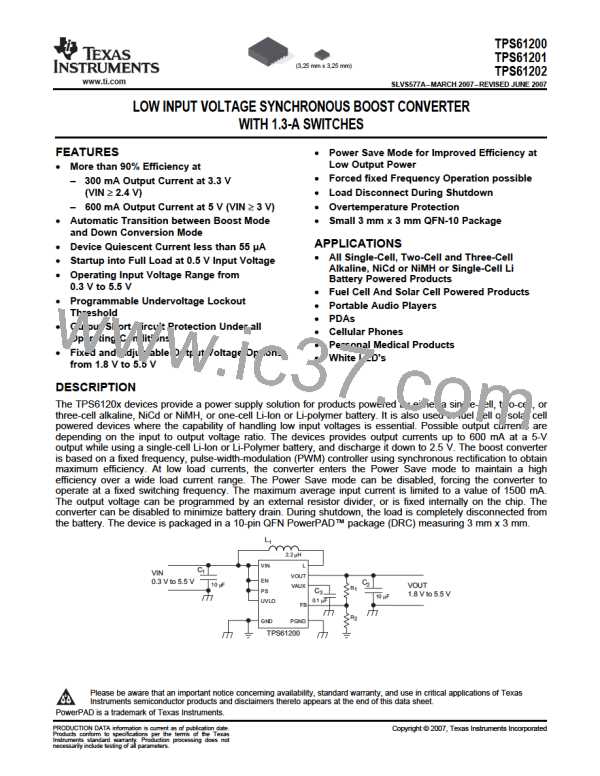TPS61200
TPS61201
TPS61202
www.ti.com
SLVS577A–MARCH 2007–REVISED JUNE 2007
DETAILED DESCRIPTION (continued)
Device Enable
The device is put into operation when EN is set high. It is put into a Shutdown mode when EN is set to GND. In
Shutdown mode, the regulator stops switching, all internal control circuitry including the low-battery comparator
is switched off, and the load is disconnected from the input. This also means that the output voltage can drop
below the input voltage during shutdown. During start-up of the converter, the duty cycle and the peak current
are limited in order to avoid high peak currents drawn from the battery.
Softstart and Short-Circuit Protection
After being enabled, the device starts operating. At first it keeps the main output VOUT disconnected, and
charges the capacitor at VAUX. If the capacitor at VAUX is charged to about 2.5 V, the device switches to
normal operation. This means VOUT is turned on and the capacitor at VOUT is charged while the load
connected to the device is supplied. To ramp up the output voltage in a controlled way, the average current limit
is set to 400 mA and rise proportional to the increase of the output voltage. At an output voltage of about 1.2 V,
the current limit is at its nominal value. If the output voltage does not increase, the current limit will not increase.
There is no timer implemented. Thus the output voltage overshoot at startup, as well as the inrush current, is
kept at a minimum. The device ramps up the output voltage in a controlled manner even if a large capacitor is
connected at the output. When the output voltage does not increase above 1.2 V, the device assumes a
short-circuit at the output, and keeps the current limit low to protect itself and the application. When there is a
short at the output during operation, the current limit is decreased accordingly.
Undervoltage Lockout
An undervoltage lockout function prevents the main output at VOUT from being supplied if the voltage at UVLO
drops below 0.25 V. When using a resistive divider at the voltage to be monitored, for example the supply
voltage, any threshold for the monitored voltage can be programmed. If in undervoltage lockout mode, the
device still maintains its supply voltage at VAUX, but it is not turned off until EN is programmed low. This
undervoltage lockout function is implemented in order to prevent the malfunctioning of the converter.
Overtemperature Protection
The device has a built-in temperature sensor which monitors the internal IC temperature. If the temperature
exceeds the programmed threshold (see electrical characteristics table), the device stops operating. As soon as
the IC temperature has decreased below the programmed threshold, it starts operating again. There is a built-in
hysteresis to avoid unstable operation at IC temperatures at the overtemperature threshold.
14
Submit Documentation Feedback

 TI [ TEXAS INSTRUMENTS ]
TI [ TEXAS INSTRUMENTS ]